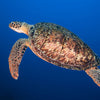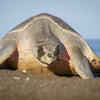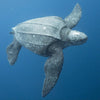Hawksbill turtles: habitat, threats and conservation measures

Hawksbill turtles: habitat, threats and conservation measures
The loggerhead turtle is a fascinating species that is one of the seven species of sea turtles. It is known for its orange to brown shell and can grow up to one meter long. However, the loggerhead sea turtle is also an endangered species and is on the Red List of Endangered Species. In this article, we will take a detailed look at the habitat, threats, and conservation measures for the loggerhead sea turtle.
Habitat and conditions
Hawksbill turtles live in the tropical and subtropical waters of the Atlantic, Pacific and Indian Oceans. They prefer shallow waters where they can feed on algae and seaweed. Hawksbill turtles spend most of their lives in the water and only come to the surface to breathe. They can live up to 140 years and reach a weight of up to 200 kilograms during this time.
Hawksbill turtles rely on a certain temperature to survive. The sand on which they lay their eggs must be at a certain temperature to promote the growth of the eggs. Ambient temperature also influences the sex of the turtles, with higher temperatures more likely to produce female turtles. The turtles lay their eggs on sandy beaches and dig holes in the sand to do so.
Threats
The loggerhead sea turtle is endangered by a variety of threats. One of the biggest threats is habitat loss. The destruction of beaches and the construction of harbors and hotels has left many turtles unable to find suitable places to lay their eggs. In addition, light pollution from artificial light sources affects the turtles' orientation on the way to the sea.
Another problem is the fishermen's nets in which the turtles are caught. The turtles get caught in the nets and can drown. Some fisheries have already started using special nets that offer turtles an escape route.
Climate change also affects the lives of loggerhead turtles. As sea levels rise, many of the beaches where turtles lay their eggs may become flooded. In addition, increasing water temperature has an impact on egg development and turtle sex distribution.
Protective measures
Many conservation measures have already been taken to preserve the loggerhead sea turtle. Creating marine protected areas is one way to protect turtle habitat. Boating and fishing are not permitted in these areas to preserve the turtle habitat. Protected areas have already been established in many countries to ensure the conservation of loggerhead turtles.
Another measure is planting beaches to preserve and protect egg-laying sites. Educating the population about the dangers of the loggerhead turtle and setting up visitor centers also helps to increase awareness of the turtle's protection.
Another important measure is reducing the use of plastic products and introducing recycling programs. Hawksbill turtles often mistake plastic waste for food and ingest it. This leads to a blockage in the digestive tract and can lead to a painful death. By reducing the use of plastic products and implementing recycling programs, we can help reduce the threat to hawksbill turtles.
Conclusion
The loggerhead sea turtle is an endangered species and it is important that we take care of its protection. The loggerhead sea turtle plays an important role in the marine ecosystem and contributes to the conservation of biodiversity. By protecting habitat and reducing threats, we can help ensure the hawksbill sea turtle's conservation.
It is important that we realize that our actions have an impact on nature. Through our actions, we can help reduce threats to the loggerhead sea turtle and protect its habitat. If we work together to protect the hawksbill turtle, we can help ensure that this fascinating species will continue to be found in our seas in the future.






